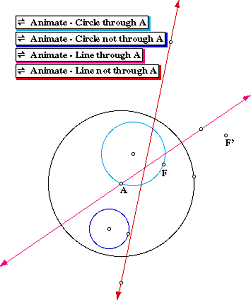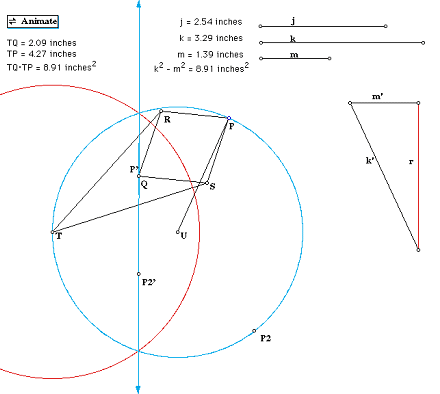| Shape inverted | Inverse of shape |
|---|---|
| Circle through A | Line not through A |
| Circle not through A | Circle not through A |
| Line through A | Line through A |
| Line not through A | Circle through A |
For a demonstration of each of these inversions, click on the sketch below.

Let r = the inversion radius. By dialation, r2 = (TQ)(TP).Explain how you can use segments of lengths j, k, and m to construct a segment of the length of the radius.
Let X be the midpoint of QP, and w = (RX). Then (QX) = (XP).
By adding line segments,(TQ) = (TX) - (QX) and (TP) = (TX) + (QX).
So (TQ)(TP) = [(TX) - (QX)] [(TX) + (QX)] = (TX)2 - (QX)2.
By pythagorean theorem, (TX)2 = k2 - w2 and (QX)2 = m2 - w2.
So now, (TQ)(TP) = (TX)2 - (QX)2 = (k2 - w2) - (m2 - w2) = k2 - m2.
Thus, r2 = k2 - m2 and r = sqrt(k2 - m2).
To construct r, create a right triangle whose legs are lengths r and m and hypothenuse is length k (so that r2 = k2 - m2).Create a Sketchpad sketch of Peaucellier's linkage which includes this circle of inversion.
- Construct a circle with any center C and radius m.
- Create a segment m' of length m between the center and any point A on the circle.
- Construct a line l through A, perpendicular to m'.
- Construct a circle with center C and radius k.
- Construct a point B at the intersection of this circle and the line l.
- Complete the triangle by constructing segment r between A and B and segment k' between C and B.
Inversion in the circle changes the objects we are familiar with in the Euclidean plane, and changes the relations between them. For instance, the inverse of a pair of parallel lines is a pair of circles that meet at the center of the circle of inversion. Other relations between objects stay the same: exercise 10 shows that inversion preserves angles if the "angle between two circles" is correctly defined.
Choose some familiar definition, axiom, or theorem from Euclidean geometry and explore its manifestation in an inverted Euclidean geometry. Discuss the consequences of any changes you discover.
For instance, the definition of "line" might be changed to mean "infinite straight objects and circles through the origin". This would have consequences for all axioms and theorems about lines. "Triangles" would no longer have straight line segments for sides, but the sum of their angles would still be 180 degrees. In an inverted geometry, statements about similarity and congruence of triangles become much more complicated.
